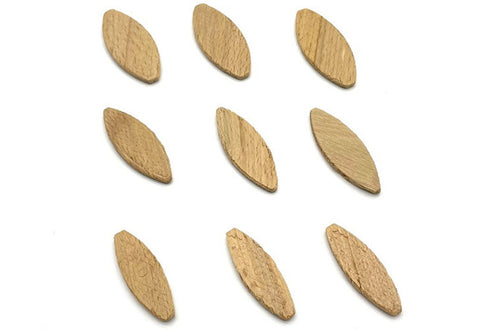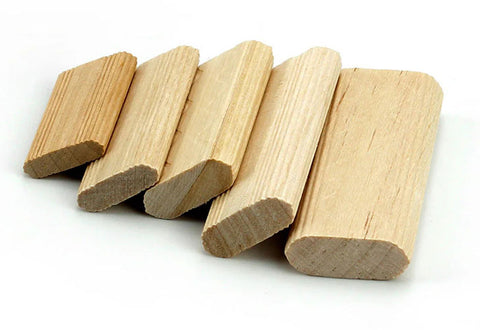In the realm of woodworking, joinery methods play a crucial role in determining the strength, durability, and aesthetic appeal of a final piece. Biscuits and dominos are two primary ways to join two pieces of wood together, and they are designed to create strong, durable, and precise connections between pieces of wood. While both serve these fundamental purposes, they have distinct features that set them apart.
This blog is a comprehensive guide on biscuit joiner vs domino, and we'll explore them among unique features, benefits, and ideal applications. By the end of this blog, we expect to provide valuable insights to help you make informed decisions for your projects.
What is a Biscuit Joiner?
A biscuit joiner, also known as a plate joiner, is a handy machine to cut a curved slot that accepts small and crescent-shaped pieces of compressed wood, typically beech, to create a reliable and strong joint. It can cut wood beech biscuits of 20, 10, and 0 sizes. This tool consists of a circular saw blade, an adjustable fence, and a base plate.
A biscuit joiner's primary goal is to align components such that two boards fit exactly when assembled. This joinery method works by cutting half-oval slots into the surface of mating edges of the wooden pieces that take compressed wood biscuits. Into these slots, oval-shaped wooden biscuits are inserted, and then you glue in an oval-shaped biscuit and clamp the joint tightly until the glue dries, the biscuit expands to make a tight and seamless joint, perfect for manufactured material like medium-density fiberboard (MDF) and plywood.
When cutting a slot to accommodate a biscuit, a biscuit joiner should cut a slot that is just slightly wider than half of its width. While allowing for some flexibility, this area makes sure that roughly half is left on either side of the joint.
It’s the most efficient way to create a biscuit joint. A biscuit joiner can be a useful tool for better face registration during the glue-up of bigger panels or tabletops, reducing the need for post-glue leveling. They provide alignment assistance and some additional strength to the joint, but they’re not as strong as other joinery methods, like mortise and tenon.
Biscuit joiners are commonly used in a wide range of woodworking projects, such as cabinets, bookshelves, tabletops, and picture frames. They are especially helpful in projects involving edge-to-edge, end-to-edge, or even end-to-end joining, resulting in a stronger joint due to the extra gluing area of the biscuits.

Pros:
Precise panel alignment and stability: It excels in its ability to align and reinforce joints, allowing for accurate and seamless joints.
Versatility: It can be used to create edge-to-edge joints, miter joints, and even corner joints. This adaptability makes biscuit joinery applicable to a wide range of woodworking projects, including furniture construction, cabinet construction, and general carpentry.
Quick and easy to use: It excels in its simplicity and ease of use, making it ideal for newcomers or those searching for a quick and efficient joinery solution.
Cons:
Weak joint strength: High joint strength applications might not be a good fit for biscuit joinery. Biscuits are pretty thin, brittle, and flimsy, even if they're filled up with glue, they absorb the glue and break very easily. The biscuits' size restricts the joint's total strength, which makes it better suited for lighter-duty applications and may not be suited for heavy-duty loads.
Limited effective uses: An obvious downside is that a biscuit joiner is limited in what it can accomplish. They have limited joint depth and are suitable only for wood surfaces with limited contact space.
What is a Domino Joiner?
A domino refers to a specialized joinery system developed by the company Festool has gained a reputation for precision and efficiency. The Festool domino is a power tool designed for mortise and tenon joinery. Unlike traditional mortise and tenon joinery, the domino acts as a floating tenon and employs a specialized tool that cuts rectangular holes into the workpieces. After the mortises are cut, domino tenons are then created on the ends of adjacent pieces. These tenons are precisely fitted into the corresponding mortises and secured with glue, resulting in a seamless and sturdy joint.
The domino is designed to simplify the process of creating mortise and tenon joints, and it excels at making precise loose mortise and tenon joints in a short amount of time with minimal effort and provides increased joint strength and alignment with remarkable accuracy and speed. Proficient woodworkers frequently utilize domino joinery, which is commonly employed to construct structural elements. It is commonly used in furniture construction like cabinets, face frames, picture frames, mitered corners, bookshelves, drawers, tables, doors, and other furniture pieces that require precise and strong joints.

Pros:
Strength and durability: It is a loose mortise and tenon joinery that is extremely strong and durable as everybody knows mortise and tenon an exceptionally strong joints, this is just a much faster version of the mortise and tenon.
The surface area for the glue: The domino has a larger surface and greater glue area in comparison to biscuits.
Adjustable depth and width: Domino can also be easily adjusted to cut at different angles to cut into the face of a board, and they are available in many sizes, lengths, and widths, and can be used for both light-duty and large-scale constructions. You can use different thicknesses depending on the size of the material you’re joining together and cut at different depths depending on the length of the domino you choose to use.
Enhances speed in production: When creating mortise and tenon joints, the domino joiner takes a lot less time and work than traditional methods. It makes the procedure easier by allowing the cutting of tenons and mortises to be done in a single operation.
Cons:
Expensive: The Festool domino is a professional-grade tool and dominos would give you a little more structural value and work well as loose tenons for breadboard applications and other loose tenon joinery. But there is a price for that convenience.
Sum Up
In conclusion, we had a careful look at the difference between biscuit joiner and domino from their features, functions, and applications. In comparison, both joinery tools are designed to do the same thing insert a small piece of wood into two opposing faces to join them together, but there are some distinctions.
The biscuit joiner is known for its versatility, affordability, and ease of use. On the other hand, the domino excels in precision, speed, and strength. It's well worth the investment if you're a professional woodworker or have strict requirements for precision and accuracy.
When it comes to cost-effectiveness, biscuit joiners are a better choice compared to some alternatives while still delivering excellent results. Moreover, if you are just going for alignment such as with table tops, etc, a biscuit joiner will give you perfect alignment vertically on your workpieces quickly and with minimal effort. If you’re building woodworking projects that require structural integrity, choosing dominos.
Explore our expansive selection of router bits and cutters for Festool domino tenons and beech wood biscuits at Findbuytool. Whether you prioritize precision, speed, or budget-friendliness, checking and browsing our pages will enable you to make informed decisions for your projects.
